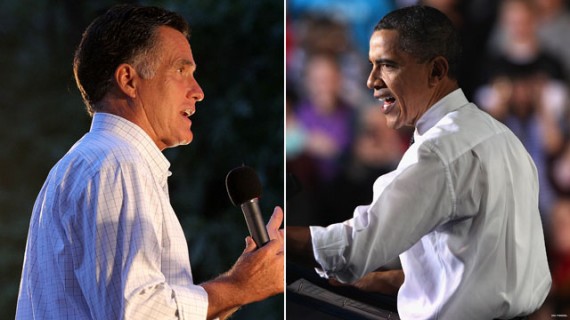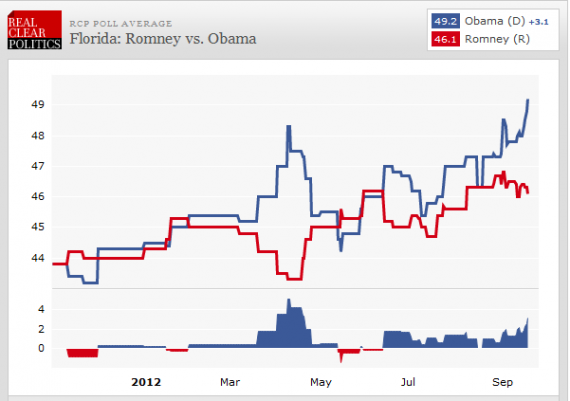More Bad Swing State News For Romney
Just a day after a trio of Washington Post polls showed Mitt Romney falling behind President Obama in three crucial swing states, a new CBS/New York Times/Quinnipiac poll of two of those states shows the more trouble for the Romney campaign:
COLUMBUS, Ohio — For weeks, Republicans in Ohio have been watching with worry that the state’s vital 18 electoral votes were trending away from Mitt Romney. The anxiety has been similar in Florida, where Republicans are concerned that President Obama is gaining the upper hand in the fight for the state’s 29 electoral votes.
Those fears are affirmed in the findings of the latest Quinnipiac University/New York Times/CBS News polls of likely voters in both states, which show that Mr. Obama has widened his lead over Mr. Romney and is outperforming him on nearly every major campaign issue, even though about half said they were disappointed in Mr. Obama’s presidency.
The polls, along with interviews with supporters and advisers in the nation’s two largest battleground states, lay bare an increasingly urgent challenge facing Mr. Romney as he prepares for his next chance to move the race in his favor, at the first debate with Mr. Obama next week. Mr. Romney’s burden is no longer to win over undecided voters, but also to woo back the voters who seem to be growing a little comfortable with the idea of a second term for Mr. Obama.
As Mr. Romney arrived in Ohio on Tuesday for a two-day bus tour and the president was set to campaign here on Wednesday, the poll also found potential openings where Mr. Romney could gain support. More voters say he would be better than Mr. Obama at tackling the budget deficit — the only major issue where he had such an edge — and a majority agree with his assertions that the government is doing too much of what should be left to individuals and businesses.
But Mr. Romney is facing mounting hurdles in these two critical states, which hold nearly as many electoral votes as the rest of the swing states combined. Mr. Romney’s lead among older Americans has shifted toward an advantage for Mr. Obama; his competitiveness with Mr. Obama on who would better handle the economy has dipped into slightly negative territory; more view Mr. Romney unfavorably than favorably — the opposite is true for the president — and majorities say Mr. Romney does not care about the problems of people like them.
(…)
The New York Times, in collaboration with Quinnipiac University and CBS News, is tracking the presidential race with recurring polls in six states. In Ohio — which no Republican has won the presidency without — Mr. Obama is leading Mr. Romney 53 percent to 43 percent in the poll. In Florida, the president leads Mr. Romney 53 to 44 percent in the poll.
The surveys, which had margins of sampling error of plus or minus three percentage points for each candidate, also included a Pennsylvania poll, where Mr. Obama is leading Mr. Romney by 12 percentage points.
The polls were conducted as the Romney campaign grappled with fallout last week from the release of his tax returns and remarks he made at a fund-raiser in which he bluntly suggested that 47 percent of Americans saw themselves as victims who are dependent on the government. That was the latest in a string of setbacks for the campaign that appe+ars to be sapping the optimism of some of his supporters.
“Romney needs a PR person,” Natalie McGee, a law student at Ohio State University who supports Mr. Romney, lamented during an interview on campus, where Obama volunteers were working to register voters and rally supportive students.
With 41 days remaining until the election, aides to Mr. Romney acknowledge that they are not leading in either state, but dispute the characterization that the race has shifted toward Mr. Obama. The political director, Rich Beeson, told reporters aboard Mr. Romney’s plane that the campaign’s internal data showed a closer race, saying, “The public polls are what they are.”
In Florida, a month after Republicans from across the country went to Tampa for their national convention, about half of the voters have an unfavorable opinion of the party. Several Republican strategists in Florida said that they believe Mr. Obama has an advantage, but disputed it was as wide as the poll suggested. Some polls have shown the race in Florida to be tighter, although Mr. Obama has consistently had an edge in nearly a dozen recent polls.
The Pennsylvania numbers are not at all surprising. Despite some thoughts from Republicans that the GOP had a shot in the Keystone State this year, a state they have not won in a Presidential election year since 1988, recent polling has shown the state moving solidly into the President’s camp. Even if you don’t buy the 12 point margin that the Quinnipiac poll gives the President, Franklin & Marshall, which has a long history of polling inside Pennsylvania, has him up by nine points. This leaves the President with a +8.3 advantage in the RealClearPolitics Average now and the overarching conclusion is that Pennsylvania will once again be safely blue come November.
Florida was one of the states in the polls released yesterday, but the result here is very different from what we saw in The Washington Post poll. That poll, and several others that have come out over the last several days, have Obama ahead by 3-4 points rather than the nine that Quinnipiac has, which may indicate some bad sampling on their part. Nonetheless, the President now has a +3.1 advantage in RCP Average in the state, and the trend in the Sunshine State is eminently clear:
Ohio is also a state that was included in the polls released yesterday, and in this case the Quinnipiac poll is relatively similar to the Post poll. As I noted yesterday, though, both of these polls are showing Obama with a larger lead than other recent polls. Nonetheless, the trend in the Buckeye State is clear. Mitt Romney has not led in any of the last eleven polls conducted in the state, and if you take out questionable polls like Gravis Marketing and Purple Strategies, as well as Rasmussen, Romney has not led in a single poll in Ohio since the General Election campaign effectively began in April when Rick Santorum dropped out of the race for the Republican nomination. The current RCP Average for the state is now +5.2 in favor of the President, a development which has caused RCP to change Ohio from a “toss up” state to “Leans Obama” in their Electoral Map Projection, giving the President a 265 to 191 advantage with 82 Electoral Votes listed as “toss ups.” Under this projection, Mitt Romney would have to win every single toss up state in order to win the election, something which is next to impossible.
Nate Silver, whose current Electoral College projections are slightly different from RCP’s, discusses the problems for Romney if he loses Ohio:
[I]t would not quite be appropriate to call Ohio a “must-win” for Mr. Romney. In fact, he could lose it and still have 14 electoral votes to spare.
Mr. Romney would burn through that slack immediately if he lost either Florida (which has 29 electoral votes) or North Carolina (which has 15).
Of these, Florida is the bigger concern for Mr. Romney. Both states have featured somewhat inconsistent polling, but Mr. Obama’s highs have been higher in the Florida polls, some of which have given him a lead in the mid-to-high single digits.
Losing both Florida and Ohio would almost assuredly be impossible for Mr. Romney to overcome. Out of the 25,001 simulations that we ran on Tuesday, there were literally zero cases in which Mr. Romney won the Electoral College despite losing both states.
A more favorable piece of news for Mr. Romney is that he could lose both Ohio and Virginia and still win the election, as they would only suffice to give Mr. Obama 268 electoral votes, although Mr. Romney would need to sweep all the other competitive states.
The combination that should perhaps most worry Mr. Romney, however, is the following: Mr. Obama wins Wisconsin and Iowa in addition to Ohio.
Usually, Wisconsin and Iowa are the alter egos of Ohio: highly competitive states that are just a bit blue-leaning, as compared to Ohio’s slightly red-tinged history.
The last time that the Democrat performed more strongly in Ohio than he did in Iowa was in 1980, when Jimmy Carter lost both states, but Ohio by a slightly narrower margin. The last Democrat to perform better in Ohio than he did in Wisconsin was Hubert H. Humphrey in 1968, who lost Ohio by two points, but Wisconsin by four.
In other words, it seems unlikely that Mr. Romney can salvage either Iowa or Wisconsin if he’s already lost Ohio – in which case he will lose the election.
That does seem to be the way things are panning out at the moment. We are one week away from the first Presidential Debate, at that point Romney will either need to start turning this race around or he’s going to find October to be a very unpleasant month.








What’s funny about those CBS/NYT/Q polls of Ohio and Florida is that to believe them you have to believe that Obama will win those states by significantly larger margins than any candidate has won them over the past 20 years. Seriously, you can look it up. Hell, Clinton in ’96 didn’t come close to winning those two states respectively by 10 and 9 points. And Clinton was presiding over a soaring economy and running against a non-funded opponent.
In any event, obviously Obama will win the pre-election media polling and by substantial margins too. It also goes without saying that Obama will win the early “exit polling” on Election Day proper, at least according to the media. And it’s certainly well within the realm of possibilities that Obama, you know, will win the actual election. For as reasons as obvious as black and white, quite literally. But the liberal media over the past couple of weeks not only has jumped the shark tank they’ve gone ahead and added a twist and half gainer to boot. The recent polling is cognitively dissonant even by media standards. We can’t agree with their tactics, nor their strategy, but we do greatly admire their determination and their sheer ruthlessness.
Florida is an outlier and may have too many Ds in the sample, but it’s still a bad poll for Romney.
The Ohio numbers are terrifying for him, however. Especially if the Obama campaign becomes confident it can shift resources to Florida or Virginia.
Right, Tsar. It’s all a big conspiracy, by the media and black people.
Jon Stewart nails why Romney is in so much trouble:
http://www.thedailyshow.com/watch/tue-september-25-2012/democalypse-2012—every-which-way-but-lucid
@Tsar Nicholas: “The recent polling is cognitively dissonant even by media standards.”
Polls can be wrong, but why should anyone doubt or be surprised to see Romney tanking? The dude just went through two of the most damaging episodes I’ve ever seen any Presidential candidate endure (Libya, 47%) and they happened virtually back-to-back and followed the Dem convention blowing the GOP one out of the water.
Mike
@Tsar Nicholas:
It is pretty funny from my left-wing perspective, but I would expect you to be in tears by now. The GOP is blowing up all around you, and you don’t even see it. Obama may very well go on and win these states by record margins. These things are cyclical, of course, so if there is a third bounce happening it will likely settle back down at least a bit.
But voting is starting… I am sending in my absentee ballot in a few days, for example. This election is not in six weeks — in some critical states it is happening now. This thing could be wrapped up, really, by mid-october, although we won’t know that for some time.
The sample for Florida and Ohio was D+9 and I believe Pennsylvania was D+11. Does anyone think that the actual election results are going to have 9% more Democrats than Republicans voting in Ohio?
Based on 2010 exit polls, R’s and D’s were tied at 36% each in FL & Ohio, and it was D+3 in Penn.
If a poll was commissioned that had a R+9 party identification, what do you think the result would be in FL, OH, and Penn?
Ah, but those are liberal newspapers …. Only the Holy Word of Rasmussen is believable!
I agree with the Tsar that Obama probably isn’t *that* far ahead, at least won’t be on election day, in those states … but it’s hard to see any evidence that Romney will *win* those states, either.
@WJW: An honest polling outfit will adjust for discrepancies in the sample. As will Nate Silver, at least when he factors the poll into the averages. Wait a couple days and see if this trend is consistent.
Based on 2010 exit polls
Apples and oranges. You don’t compare midterm turnout with presidential-election turnout.
@Tsar Nicholas:
The difference is that Clinton was facing a more competent Republican. Dole may have been boring and ineffectual (hell, he seemed barely conscious at times), but he at least didn’t offend people. Romney is easily the worst general election presidential nominee since at least Dukakis. His Libya statement and the 47% speech were so insanely damaging, it would be tough for even a likeable and charming candidate to overcome. But the Romneybot doesn’t have a chance.
FL is a bit of an outlier, but Obama is till up by 4-5 points there.
OH and VA aren’t surprising though.
@WJW:
How many of the independents in the sample lean R, how many lean D? How much do they lean? Are they true independents?
You seem to be oblivious to the fact that a lot of voters who are going to vote for the Republican actually consider themselves Independents.
@PJ: Exactly, which makes the crying about party ID’s laughable.
This stuff is fluid people, right now more people consider themselves Democrats.
I think we may now be seeing the impact of the 47 percent comment, which was damning for Romney not just for what he said, but also the tone with which he said it. Sneering contempt from a sheltered rich guy doesn’t go down well, especially when said rich guy is seen as conforming to every negative caricature of him that’s out there.
Somewhere, David Corn is smiling.
Since all three states have been aggressively attempting to redefine who can vote, I wouldn’t take any of them for granted.
The likely voter screens are unlikely to factor in the complete clusterf.ck that Pennsylvania wants to create in busy polling places this year, for instance.
This thing is fundamentally over. If it were a movie, the soundtrack would have switched to a minor key, and we would know the hatchet man were nearby even if he hadn’t shown up on the screen yet.
This is a combination of a mediocre candidate with a bad platform against a reasonably popular incumbent.
This election will be a footnote in history, except perhaps for the unwillingness of either candidate to talk much about climate change.
@Curtis:
The incumbent isn’t popular; his approval ratings have been consistently below 50%. He’s just been gifted with even less popular opponents.
@Stormy Dragon: His job approval ratings have been low, but his favorables have been pretty good during a depressed economy.
I should have added , “especially during a depressed economy.” And I apologize for the bad linking.